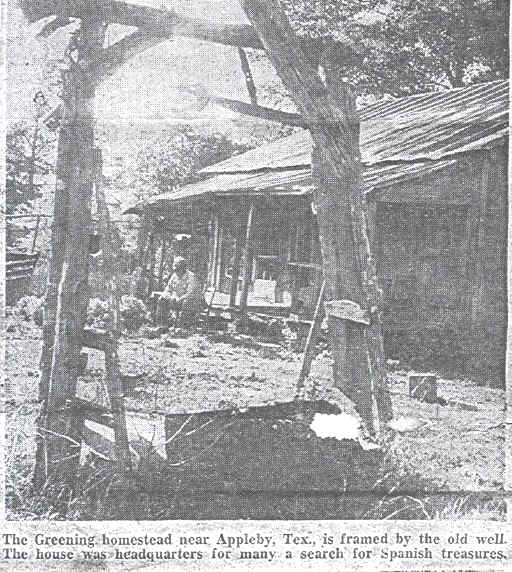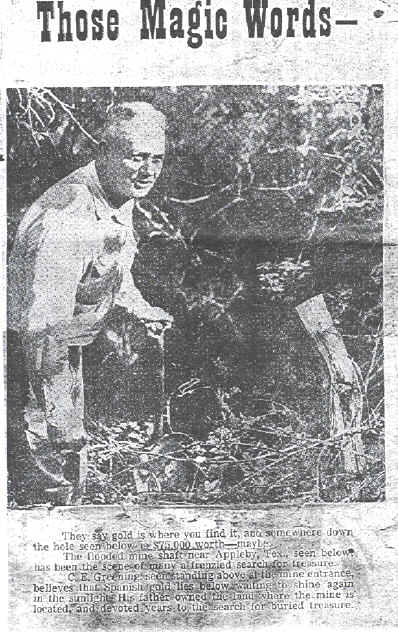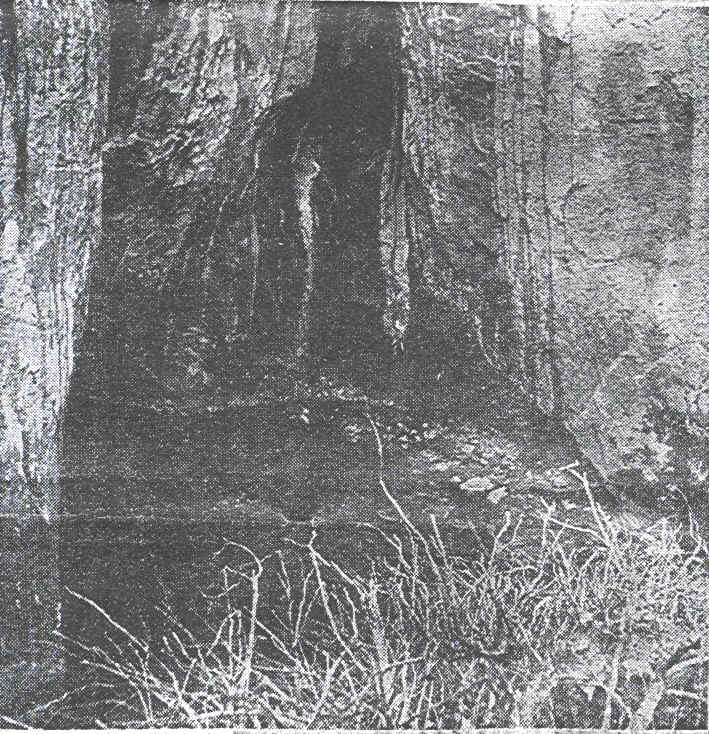
BURIED TREASURE
STORY CONCERNING THE OLD "MONEY WELL" ON
THE GREENING PROPERTY
IN NACOGDOCHES COUNTY, TEXAS
The Shreveport Times, Sunday, April 16, 1967 (3-G)
By Jerry Arnold
Times Assistant State Editor
A small, red cloud of dust churned about his feet as he shuffled along the road towards Appleby, a sleepy little hamlet deep in the Piney-woods of East Texas.
The cold, February wind whispered outside the corner grocery store where the town's idlers, hugging the wood burning stove, were whittling while they discussed the topics popular in 1907.
The little man, a Mexican with one leg shorter than the other, was Hoppin' Bell, a self-proclaimed great grandson of the famed Mexican General Santa Ana, he was a man in a hurry and little time for small talk with the old men.
From a dirty pocket, Hoppin' Bell unrolled a parchment " way bill", a plot of the area showing the location of an abandoned gold mine, which had been worked extensively by the Spaniards before the War for Texas Independence.
Although countless legends of lost treasures had often found their way into many an old timer's conversation, no one had ever taken any of the tales seriously. At least, not until Hoppin' Bell spread the yellowing map on an overturned empty cracker barrel.
His finger darting from symbol to symbol, Hoppin' Bell translated the map's inscriptions as the curious idlers huddled around the barrel, craning their necks for a closer look.
Arguments flared. But, after considerable discussion, all agreed the area plotted on the map had to be the T J Greening farm Northeast of town.
Hoppin' Bell hurriedly rolled up the parchment, tucked it in his pocket and hobbled, sometimes stumbling, toward Greening's homestead.
Greening was a proud man. A simple farmer, he had recently bought 48 acres of the most fertile land around Appleby.
Despite the chilling late winter wind, Greening was eager to prepare the virgin soil of his new farm for an early crop.
He straddled the fresh-turned mounds of dirt as he steadied the wooden plow behind the mule.
Greening heard Hoppin' Bell shuffling through the woods toward him, but he didn't see the little man until the barrel of a shotgun protruded from behind a bush nearby.
Greening froze, puzzled, he stared at the Mexican, "Get off my land" Hoppin' Bell shouted.
"Your land, what do you mean? " Greening asked. "I bought this land...paid good money for it," he explained.
Lowering the shotgun slightly, Hoppin' Bell came forward. " I've got a paper here that says this land is mine," the Mexican insisted.
The two argued for awhile. Neither seemed to be getting anywhere, until Greening said, "Let me go up to the house and get my gun, and we'll settle this thing for good.."
Hoppin' Bell had come too far to risk being shot. He lowered the gun to the ground.
The two talked for awhile and Greening convinced the Mexican he owned the land.
Pulling the wrinkled parchment from his pocket, Hoppin' Bell said "Mis-ter, if you let me show you something, you won't ever have to plow this field again for awhile."
Hesitating, Greening approached the strange little man who had spread the map on the ground. Hoppin' Bell excitedly explained the unusual markings as Greening, still standing, leaned over his shoulder.
Hoppin' Bell's map had four corners to a plot of land where the mine was to be found. The Spaniards, so he said, had tunneled into a big hill from the side, and had sunk an air shaft down the middle.
When the Texans were crowding Santa Ana, there was some $75,000. in gold already mined and loaded on the backs of 14 oxen and other packs.
The nuggets were pounded into masses ranging from the size of a fist to a horse's head, so Hoppin' Bell said.
Crafty Santa Ana, realizing he could never get the ore to the smelter in Mexico, sank the gold in the large air shaft, then he covered the shaft with a huge rock.
One corner of the plot was marked with a coiled-snake carved into the trunk of a large oak tree. The snake's head was carved on a root of the tree, pointing towards the second marker, a pistol in an old hollow tree.
Another marker was the wood stock of a Bennington rifle, shoved in the ground. The fourth marker was a large rock in a creek bed, inscribed with Spanish symbols.
Hoppin' Bell hobbled through the woods on Greening's hills for weeks until they found the first marker, the coiled-snake...and when they found it, people began to believe Hoppin' Bell's tale.
When they discovered the solid rock, jutting out of the Guatholope, or Turkey Creek, and showed the town's people the glistening sands of gold, the whole town entered into the search for the lost mine.
It took four men and two mules to move the two-ton boulder from the mine's entrance. The men frantically dug the gnarled brush away and found the gaping mouth of the old shaft.
Digging was started, but had not gone far when the weary and aged Hoppin' Bell died while digging at the shaft's bottom.
Working long hours, often starving himself to work in the shaft, Greening contracted an incurable affliction, and he was bedridden for the remainder of his life. *
After a while work was halted, and the old mine shaft was all but forgotten. The farmers returned to their fields to make their livelihood.
But, Hoppin' Bell's legend hasn't been forgotten by those who live in Appleby today.
The little Mexican left such a lure of gold behind him, that boys of his day now grown to manhood, reach into their pockets and proudly display rocks and pebbles they have found in their rambles through the hilly piney-woods, searching for lost treasure.
Greening's eldest son, C. E. Greening, ** who until recently owned the tract of land where the old shaft was located, believes as strongly as his father and old Hoppin' Bell.
"There's Gold in Them Thar Hills."
------------------------------------------------------
.
This place had been abandoned since 1949, when
this picture was made in1967. The last Greening home, the REAR of which is pictured above, was built in
1932, replacing their home, which was built in 1917 and destroyed by fire, on 3/31/1932.
The original home, where the family lived from 1898 until 1917, was located near
the old "money well", and was most likely the "headquarters"
of the Spanish treasure hunt.-SGS

 article
Courtesy of John D. Greening of
Shreveport, La., gr/son of S. W. Greening
article
Courtesy of John D. Greening of
Shreveport, La., gr/son of S. W. Greening
* T J Greening was not bedridden prior to his final 6 weeks of
life, according to other children. He died of a kidney ailment. SGS ** C. E. Greening was not the eldest
son-sgs
Pictures by Jerry Arnold
A similar article had appeared in the Houston Chronicle in
1948/49